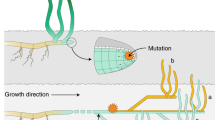Abstract
Gracilaria chilensis exhibits noticeable intraclonal variation, some of which is presumed to result from mitotic recombinations or other types of DNA turnover associated with replication activities during cellular division. To test this, genetic variability (determined by multilocus fingerprinting markers using the randomly amplified polymorphic DNA technique, RAPD) and total growth were simultaneously measured over time in clonal replicates of G. chilensis incubated under controlled laboratory conditions. The results suggest that genetic variability increases as growth occurs and biomass accumulates, supporting the hypothesis of growth-related increases in genetic heterogeneity. For species massively propagated by thallus fragmentation in either naturally or farmed populations, growth-dependent genetic changes may constitute a powerful means of generating intra-population variation without thalli becoming reproductively mature, and, as a consequence, bypassing meiosis and/or sexual recombination.
Similar content being viewed by others
Author information
Authors and Affiliations
Additional information
Received: 6 May 1998 / Accepted: 30 July 1999
Rights and permissions
About this article
Cite this article
Meneses, I., Santelices, B. & Sánchez, P. Growth-related intraclonal genetic changes in Gracilaria chilensis (Gracilariales: Rhodophyta). Marine Biology 135, 391–397 (1999). https://doi.org/10.1007/s002270050639
Issue Date:
DOI: https://doi.org/10.1007/s002270050639




